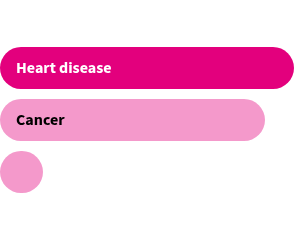Which states have the highest maternal mortality rates?
Tennessee had the highest maternal mortality rate between 2019 and 2023.
Maternal mortality — when a woman dies while pregnant or within 42 days after a pregnancy — is an important maternal health indicator. In 2023, there were 669 maternal deaths in the United States, a maternal mortality rate of 18.6 deaths per 100,000 live births. The Centers for Disease Control and Prevention (CDC) estimates that more than 80% of all pregnancy-related deaths in the U.S. are preventable.
Maternal mortality rates vary from state to state. Tennessee had the highest aggregate maternal mortality rate from 2019 to 2023, with 42.1 deaths per 100,000 births, followed by Louisiana (40.7) and Mississippi (39.7). California had the lowest, 10.1, and Minnesota was second-lowest with 14.1.
Data is only available for 39 states: The CDC suppresses maternal death counts from states with nine deaths or fewer in the interests of confidentiality, and from states with 20 deaths or fewer to ensure data integrity.
Tennessee had the highest maternal mortality rate — California the lowest.
Maternal mortality rate per 100,000 births, aggregated from 2019–2023
How does maternal mortality vary by race?
In 2023, Black, non-Hispanic women had the highest maternal mortality rate of any racial or ethnic group, with 50.3 deaths per 100,000 births. Their rate was 2.7 times the US average and nearly 3.5 times that of white, non-Hispanic women, who had the second-highest rate (14.5). Asian, non-Hispanic women had the lowest rate, 10.7.
From 2022 to 2023, maternal mortality rates fell among all racial and ethnic groups except Black women, who faced a 1.6% increase. Rates fell the most for Hispanic women, going from 16.9 deaths per 100,000 births in 2022 to 12.4 in 2023 — down 26.6%.
Rates of maternal mortality among Black women are 2.7 times the US average.
Maternal mortality rates (per 100,000 live births) by race/ethnicity, 2023
What causes maternal mortality?
A range of factors, both socioeconomic and physical, can lead to a pregnant woman’s death.
Socioeconomic conditions can influence both an expecting mother’s health and access to high-quality prenatal care. In terms of specific physical causes, the largest proportion of deaths were caused by:
- hemorrhages or excessive bleeding (18.1%)
- infection or sepsis, non-COVID-19 related (14.0%)
- blood clots (11.5%)
- chronic heart disease (10.2%)
About 1 out of 5 were other unspecified conditions (11.0% non-heart related or 10.4% heart related).
Hemorrhage or infection were the leading causes of death related to pregnancy.
Share of maternal mortalities by cause of death, 2023
In an effort to reduce maternal mortality rates, the CDC’s Eliminate Maternal Mortality Program partners with state and local-level Maternal Mortality Review Committees in 49 states (all except Texas and DC), and funds 46 (awards have not gone to Texas, Idaho, North Dakota, or Florida). These committees are made up of gynecologists, midwives, nurses, mental health professionals, and patient advocates who collaborate to implement interventions aimed at preventing pregnancy-related deaths.
How have maternal mortality rates changed over time?
Pregnancy was markedly more dangerous for women historically than in recent decades. From 1915 to 1933, the average maternal mortality rate was above 600 deaths per 100,000 births, more than 32 times higher than the 2023 rate. In 1918, during the Great Influenza pandemic (also known as the “Spanish flu”), maternal mortality peaked at 916.4 per 100,000 births. Then, between 1929 and 1949 a plummet: the rate dropped from 695 to 90 deaths per 100,000 births, more than a seven-fold decrease.
The CDC cites scientific advancements of the 1930s and ’40s — the discovery of antimicrobial agents (sulfonamide in 1937 and penicillin in the 1940s), and the development of fluid replacement therapy and safe blood transfusions — as accelerants in the maternal mortality rate reduction, along with general improvements in education, sanitation, and overall standards of living.

More recently, the National Center for Health Statistics went through an effort to improve the data collection process with states that took place between 2003 and 2017 in response to research indicating that reporting methods historically led to undercounts. The first full year of newly standardized data was 2018.
How have rates fluctuated in the past decade?
Between 2018 and 2023, maternal mortality had a low of 17.4 deaths per 100,000 births in 2018 and a peak of 32.9 in 2021. COVID-19 was the leading cause of death in 2021 (40.5% of total maternal mortality) and 2020 (14.7%). Maternal mortality then fell 44% from 2021 to 2023, due in part to the decrease in the percentage of deaths attributable to COVID-19.
The maternal mortality rate was over 35 times higher in 1923 vs. 2023.
Maternal mortality rate (deaths per 100,000 births), 1915–2023
Find out more about the state of health in America, the infant mortality rate, and get facts delivered to your inbox weekly by signing up for our newsletter.
